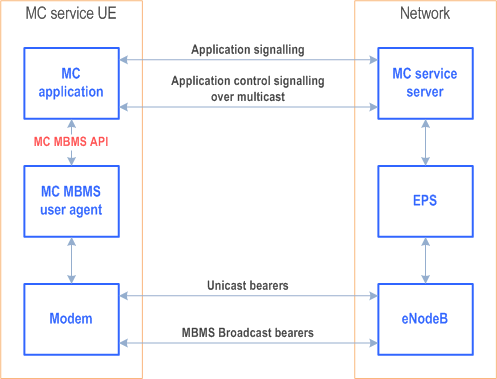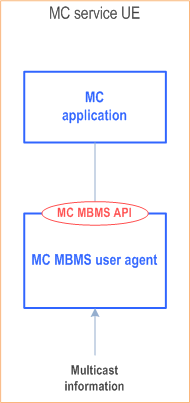Content for TS 23.479 Word version: 18.0.0
0 Introduction
1 Scope
2 References
3 Definitions and abbreviations
3.1 Definitions
3.2 Abbreviations
4 Functional architecture
4.1 General
4.2 System architecture
4.3 Functional model
4.3.1 Functional model of MC MBMS API
4.3.2 MC application
4.3.3 MC MBMS user agent
...
...
0 Introduction p. 5
The LTE MBMS bearer service is used to support group communications of mission critical services through the GCSE enabler. The present document is targeted at facilitating interactions of group communications between mission critical applications and MBMS bearer services within the UE.
The present document defines abstract functionalities of application programming interface that allow mission critical applications to use MBMS capabilities without requiring access to implementation logic of MBMS operations. The API functionalities defined in the present document are platform and language independent. Related study was conducted in TR 23.792.
1 Scope p. 6
The present document defines the application programming interface on the UE for mission critical applications to access mission critical services over MBMS.
This document identifies system architecture and functional model for the definition of the MBMS API for mission critical services.
2 References p. 6
The following documents contain provisions which, through reference in this text, constitute provisions of the present document.
- References are either specific (identified by date of publication, edition number, version number, etc.) or non-specific.
- For a specific reference, subsequent revisions do not apply.
- For a non-specific reference, the latest version applies. In the case of a reference to a 3GPP document (including a GSM document), a non-specific reference implicitly refers to the latest version of that document in the same Release as the present document.
[1]
TR 21.905: "Vocabulary for 3GPP Specifications".
[2]
TS 23.468: "Group Communication System Enablers for LTE (GCSE_LTE); Stage 2".
[3]
TS 23.280: "Common functional architecture to support mission critical services; Stage 2".
[4]
TS 23.379: "Functional architecture and information flows to support Mission Critical Push To Talk (MCPTT); Stage 2".
[5]
TS 23.281: "Functional architecture and information flows to support Mission Critical Video (MCVideo); Stage 2".
[6]
TS 23.282: "Functional architecture and information flows to support Mission Critical Data (MCData); Stage 2".
[7]
TR 23.792: "Study on MBMS APIs for Mission Critical Services".
3 Definitions and abbreviations p. 6
3.1 Definitions p. 6
For the purposes of the present document, the terms and definitions given in TR 21.905 and the following apply. A term defined in the present document takes precedence over the definition of the same term, if any, in TR 21.905.
MC MBMS API:
An application programming interface on the UE to enable the use of MBMS bearer service for mission critical applications.
MBMS bearer availability:
Presence of the TMGI identifying an MBMS bearer within the radio control channels.
MBMS bearer quality monitoring:
Continuous evaluation of the reception quality of an MBMS bearer, with or without data being received on the MBMS bearer.
MBMS subchannel:
A logical channel which uses resources of an activated and announced MBMS bearer identified by the TMGI of the MBMS bearer and additional parameters, e.g. UDP port.
3.2 Abbreviations p. 7
For the purposes of the present document, the abbreviations given in TR 21.905 and the following apply. An abbreviation defined in the present document takes precedence over the definition of the same abbreviation, if any, in TR 21.905.
API
Application Programming Interface
BM-SC
Broadcast Multicast Service Centre
ECGI
E-UTRAN Cell Global Identifier
E-UTRAN
Evolved Universal Terrestrial Radio Access Network
FEC
Forward Error Correction
MBMS
Multimedia Broadcast and Multicast Service
MCA
MC Application
MC-MUA
MC MBMS user agent
MCCH
Multicast Control Channel
MCData
Mission Critical Data
MCPTT
Mission Critical Push To Talk
MCVideo
Mission Critical Video
ROHC
Robust Header Compression
SAI
Service Area Identity
SDP
Session Description Protocol
TMGI
Temporary Mobile Group Identity
4 Functional architecture p. 7
4.1 General p. 7
This clause specifies the functional model of the MC MBMS API within the MC service UE (as described in clause 4.3), and the system architecture (as described in clause 4.2).
4.2 System architecture p. 7
This clause demonstrates the end-to-end MC service architecture with the use of MC MBMS API for MC multicast operations.
Figure 4.2-1 shows the system architecture for mission critical communications. In the system architecture GCSE communications as defined in TS 23.468 is supported. When representing the MC service client, the MC application accesses the MBMS resource on MC MBMS user agent through the MC MBMS API, based on information in application signalling over MCPTT-1, MCVideo-1 or relevant interfaces of MCData service. Some multicast related information acquired through the MC MBMS API are used by the MC application to report to the MC service server over application signalling.

4.3 Functional model p. 8
4.3.1 Functional model of MC MBMS API p. 8
Figure 4.3.1-1 shows the functional model of the MC MBMS API which resides between the MC application and MC MBMS user agent on the MC service UE.

In the functional model the MC application can represent an MC service client.
The MC MBMS user agent supports the MC service client functions in receiving the MBMS bearer data for the use of MBMS transmission defined in TS 23.280, TS 23.379, TS 23.281 and TS 23.282.
4.3.2 MC application p. 9
The MC application invokes the MC MBMS API to access and manage the MBMS bearers to support MC services.
The MC application supports the following functions:
- Registration and deregistration to the MC MBMS user agent;
- Reception of application level control signalling messages;
- Activation and termination of MBMS bearer quality monitoring;
- Obtaining MBMS bearer availability through the MC MBMS API;
- Obtaining MBMS bearer suspension and resumption status through the MC MBMS API;
- Reception of media with or without FEC encoding and media with or without ROHC compression from the MC MBMS user agent;
- Obtaining location information for MBMS usage through the MC MBMS API;
- Configuration of the MC MBMS user agent; and
- Retrieve capabilities of MC MBMS user agent.
4.3.3 MC MBMS user agent p. 9
The MC MBMS user agent may provide MBMS media with FEC and ROHC to the MC application.
One or more MC application(s) use the MC MBMS API provided by the MC MBMS user agent.
The MC MBMS user agent supports the following functions:
- Detection of location information for MBMS usage;
- Detection of MBMS bearer availability;
- Report of MBMS bearer quality to the MC application;
- Reception of MBMS data from a lower layer of the UE;
- Detection of suspension of MBMS bearer; and
- Delivery of media with or without FEC encoding and media with or without ROHC compression to the MC application.